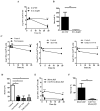SopB activates the Akt-YAP pathway to promote Salmonella survival within B cells
- PMID: 30103648
- PMCID: PMC6177241
- DOI: 10.1080/21505594.2018.1509664
SopB activates the Akt-YAP pathway to promote Salmonella survival within B cells
Abstract
B cells are a target of Salmonella infection, allowing bacteria survival without inducing pyroptosis. This event is due to downregulation of Nlrc4 expression and lack of inflammasome complex activation, which impairs the secretion of IL-1β. YAP phosphorylation is required for downregulation of Nlrc4 in B cells during Salmonella infection; however, the microorganism's mechanisms underlying the inhibition of the NLRC4 inflammasome in B cells are not fully understood. Our findings demonstrate that the Salmonella effector SopB triggers a signaling cascade involving PI3K, PDK1 and mTORC2 that activates Akt with consequent phosphorylation of YAP. When we deleted sopB in Salmonella, infected B cells that lack Rictor, or inhibited the signaling cascade using a pharmacological approach, we were able to restore the function of the NLRC4 inflammasome in B cells and the ability to control the infection. Furthermore, B cells from infected mice exhibited activation of Akt and YAP phosphorylation, suggesting that Salmonella also triggers this pathway in vivo. In summary, our data demonstrate that the Salmonella effector inositide phosphate phosphatase SopB triggers the PI3K-Akt-YAP pathway to inhibit the NLRC4 inflammasome in B cells. This study provides further evidence that Salmonella triggers cellular mechanisms in B lymphocytes to manipulate the host environment by turning it into a survival niche to establish a successful infection.
Keywords: Akt; B cells; IL-1β; Salmonella; SopB; YAP.
Figures






Similar articles
-
Salmonella Promotes Its Own Survival in B Cells by Inhibiting Autophagy.Cells. 2022 Jun 29;11(13):2061. doi: 10.3390/cells11132061. Cells. 2022. PMID: 35805144 Free PMC article.
-
Salmonella downregulates Nod-like receptor family CARD domain containing protein 4 expression to promote its survival in B cells by preventing inflammasome activation and cell death.J Immunol. 2013 Feb 1;190(3):1201-9. doi: 10.4049/jimmunol.1200415. Epub 2013 Jan 2. J Immunol. 2013. PMID: 23284055
-
Cirtical role for Salmonella effector SopB in regulating inflammasome activation.Mol Immunol. 2017 Oct;90:280-286. doi: 10.1016/j.molimm.2017.07.011. Epub 2017 Aug 30. Mol Immunol. 2017. PMID: 28846926
-
Akt scaffold proteins: the key to controlling specificity of Akt signaling.Am J Physiol Cell Physiol. 2021 Sep 1;321(3):C429-C442. doi: 10.1152/ajpcell.00146.2020. Epub 2021 Jun 23. Am J Physiol Cell Physiol. 2021. PMID: 34161152 Review.
-
Roles of THEM4 in the Akt pathway: a double-edged sword.J Zhejiang Univ Sci B. 2024 Jul 15;25(7):541-556. doi: 10.1631/jzus.B2300457. J Zhejiang Univ Sci B. 2024. PMID: 39011675 Free PMC article. Review.
Cited by
-
Prevalence, antimicrobial resistance and virulence genes of Salmonella serovars isolated from humans and animals.Vet Res Commun. 2022 Sep;46(3):799-810. doi: 10.1007/s11259-022-09900-z. Epub 2022 Feb 15. Vet Res Commun. 2022. PMID: 35167002
-
Strategies adopted by Salmonella to survive in host: a review.Arch Microbiol. 2023 Oct 31;205(12):362. doi: 10.1007/s00203-023-03702-w. Arch Microbiol. 2023. PMID: 37904066 Review.
-
The interplay between Salmonella and host: Mechanisms and strategies for bacterial survival.Cell Insight. 2025 Feb 13;4(2):100237. doi: 10.1016/j.cellin.2025.100237. eCollection 2025 Apr. Cell Insight. 2025. PMID: 40177681 Free PMC article. Review.
-
Salmonella Infantis Delays the Death of Infected Epithelial Cells to Aggravate Bacterial Load by Intermittent Phosphorylation of Akt With SopB.Front Immunol. 2021 Nov 5;12:757909. doi: 10.3389/fimmu.2021.757909. eCollection 2021. Front Immunol. 2021. PMID: 34804044 Free PMC article.
-
Salmonella Promotes Its Own Survival in B Cells by Inhibiting Autophagy.Cells. 2022 Jun 29;11(13):2061. doi: 10.3390/cells11132061. Cells. 2022. PMID: 35805144 Free PMC article.
References
Publication types
MeSH terms
Substances
LinkOut - more resources
Full Text Sources
Other Literature Sources
Molecular Biology Databases
Miscellaneous
